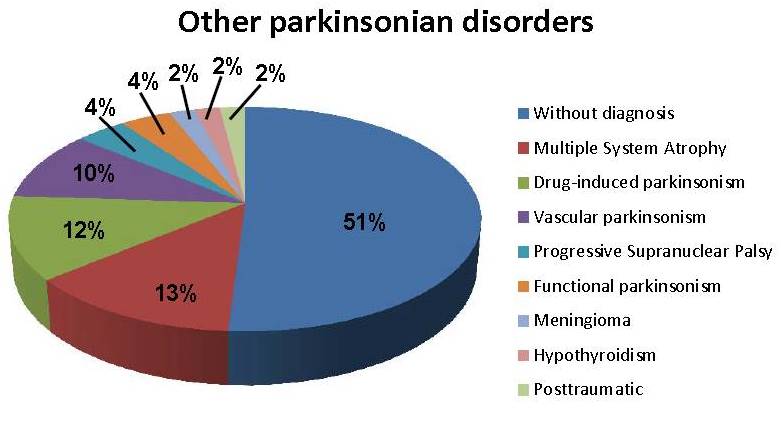Session Information
Date: Monday, June 5, 2017
Session Title: Parkinsonism, MSA, PSP (Secondary and Parkinsonism-Plus)
Session Time: 1:45pm-3:15pm
Location: Exhibit Hall C
Objective: To identify the epidemiological profile of patients with parkinsonism in a tertiary movement disorders clinic in the northeast of Brazil.To identify the epidemiological profile of patients with parkinsonism in a tertiary movement disorders clinic in the northeast of Brazil.
Background: Parkinsonism is defined by the presence of bradykinesia with either resting tremor, rigidity and postural instability. Parkinson’s Disease is the most common neurodegenerative pathology, characterized by asymmetrical levodopa-responsive parkinsonism, that can be preceded or followed by non-motor symptoms, such as hyposmia, REM Sleep Behaviour Disorder, constipation, insomnia and depression. Differential diagnosis must be made with other parkinsonian syndromes, such as drug-induced parkinsonism (DIP), vascular parkinsonism, Multiple System Atrophy and Progressive Supranuclear Palsy.
Methods: 169 medical records were evaluated and the presence of either “Parkinson’s Disease” or “Other Parkinsonism” was accounted. Gender, age at diagnosis, non-motor symptoms and psychiatric disorders were also evaluated.
Results: 73% of the sample had Parkinson’s Disease while 27% had other forms of parkinsonism, such as Multiple System Atrophy (13%), vascular parkinsonism (10%), Progressive Supranuclear Palsy (4%) and drug-induced parkinsonism (12%) (Figure 1). Male gender prevailed in patients with Parkinson’s Disease, while a higher proportion of women was found in those with other parkinsonian disorders. Mean age was 61 years age and the most prevalent non-motor symptoms was constipation (29%) and REM Sleep Behaviour Disorder (8%). 44% of the group with Parkinson’s Disease had a psychiatric disturbance, especially mood disorders (82%) and psychosis (16%).
Conclusions: Like previous researches, Parkinson’s Disease representes the leading Pathology related to parkinsonian disorder in a tertiary clinic specialized in movement disorders. Constipation was the most common non-motor feature, followed by mood disorders. Parkinson’s Disease usually manifest in older individuals, which creates additional functional impairment in these individuals. With better understanding of the epidemiological profile of parkinsonian disorders in our clinic, we will be able to define to define better diagnostic and therapeutic assessment and, consequently, improvement of quality of life for patients suffering from this neurological condition.
References: Barbosa, E.R.; Sallem, F.A.Z. – Parkinsons disease–diagnosis. Rev. Neurociências, v. 13, n. 3, p. 158-165, 2005.
Dickson, D.W. – Parkinson’s disease and parkinsonism: neuropathology. Cold Spring Harbor perspectives in medicine, v. 2, n. 8, 2012.
To cite this abstract in AMA style:
R. Prado, P. Macêdo, A. Santiago, R. Sá, J. Santos, M. Machado. Epidemiological profile of parkinsonism in a tertiary neurological clinic in the northeast of Brazil. [abstract]. Mov Disord. 2017; 32 (suppl 2). https://www.mdsabstracts.org/abstract/epidemiological-profile-of-parkinsonism-in-a-tertiary-neurological-clinic-in-the-northeast-of-brazil/. Accessed April 20, 2025.« Back to 2017 International Congress
MDS Abstracts - https://www.mdsabstracts.org/abstract/epidemiological-profile-of-parkinsonism-in-a-tertiary-neurological-clinic-in-the-northeast-of-brazil/

